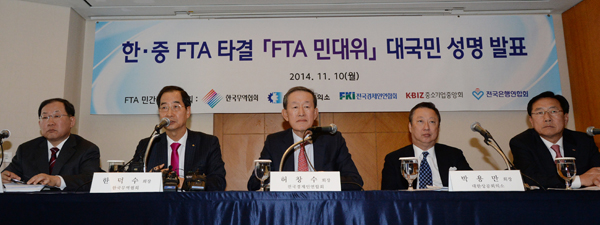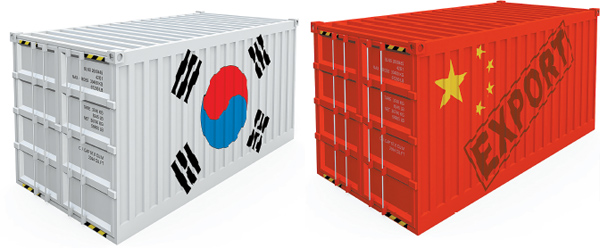Cosmetics and transportation industries are smiling

Top business and financial lobby groups gathered to comment on the FTA that Korea has agreed upon with China yesterday at Lotte Hotel in downtown Seoul. From left: Bahk Byong-won, Korea Federation of Banks chairman; Han Duck-soo, Korea International Trade Association chairman; Huh Chang-soo, Federation of Korean Industries chairman; and Kim Ki-moon, Korea Federation of Small and Medium Business chairman. [NEWSIS]
Automobiles, electronics

“Korea wanted to protect its rice market, while China wanted to protect its car industry,” said Han Duck-soo, chairman of the Korea International Trade Association (KITA). “But I think it won’t be a big deal because Korean automakers already have manufacturing plants in China.”

Industry insiders worried the agreement might threaten Korean automakers on their home soil because Volkswagen, Audi and BMW, which manufacture cars in China, would bring in more if the tariff were lowered.
Korean auto parts makers are expected to benefit from the agreement. China currently imposes tariffs of 6 to 10 percent on auto parts, but since China agreed to lower the barrier, Korean manufacturers that have better technology are expected to sell their products at lower prices.
“It is still hard to estimate how much Korea will benefit because car steel sheets, for which Korea is the industry leader, were excluded from the agreement,” said Kim Jin-woo, a researcher at Korea Investment and Securities. “Koreans, however, will soon enjoy selling hot-rolled steel sheets, since that tariff will be removed immediately.”
Any benefit to the electronics industry also will be limited as the major companies already have production in China, while products like semiconductors, PCs and mobile phones already are tariff free under the World Trade Organization’s Information Technology Agreement.
“The FTA might increase export volume between two countries and secure price competitiveness, but since we have a production base in China, we don’t expect major changes,” said an official from Samsung Electronics. “However, the deal is likely to enhance export infrastructure.”
Transportation, petrochemicals
For the transportation industry, the Korea-China FTA is seen as a boost, as trade between the two countries increases.
For maritime shippers, which have been struggling, midsize companies that have been operating in nearby Asian countries are likely to benefit the most.
“It’s certainly good news for us because shipments will naturally increase,” said an official from the Korea Shipowners’ Association. “Instead of major shippers that operate trans-Atlantic or Pacific routes, midsize and small shippers that focus on regional routes are more likely to welcome the news.”
Airlines also welcomed the FTA as they expect more travel and shipping volume. The air carriers are hoping the deal could eventually lead to an open-skies agreement.
Asiana Airlines, which offers 30 routes to 22 Chinese cities, the most of any Korean carrier, said the FTA will give more opportunities to grow.
“We expect an increase in business travelers, while cargo demand is also expected to rise,” said the affiliate of Kumho Asiana Group in a press release.
Korean Air Lines, the nation’s largest flag carrier, said it also expects more business and will work to reinforce its network in China. KAL flights to China account for 12 percent of ticket sales.
The FTA also is expected to be good for the Korean oil and petrochemical industry. More than 40 percent of petrochemical products and 18 percent of oil products produced in Korea are exported to China.
Although existing tariffs on gasoline and diesel products are small, they expect big changes in lubricant and petrochemical products, which generally have tariffs of 5 to 6 percent.
Retail
In the retail and services sector, analysts warn that the market for inexpensive products might be dominated by Chinese companies backed by the FTA.
“Based on free-trade impact assessment, local textile, clothing and household-item manufacturers will be affected by the Korea-China free trade agreement,” said Kim Byung-yeon, an analyst at Woori Investment & Securities.
But others said a Chinese-product tsunami in local stores is unlikely.
“At big discount supermarkets, household items imported from EU countries already are available and cheaper than Chinese products,” said an official at E-Mart who spoke on the condition of anonymity. “Even if the tariff is removed, it would not likely mean significant price competitiveness for China.”
When it comes to the fashion industry, the FTA is seen as a mixed bag.
Kim forecast that local fast-fashion brands and low-priced labels will suffer. On the other hand, high-end fashion companies like LG Fashion, Basic House and E-Land could broaden their appeal in China with lower prices.
As the e-commerce sector opens up, Chinese-language online shopping malls can benefit from the accord. When the FTA takes effect, China will eliminate taxes on items below 1,000 yuan ($163). Interpark recently opened Chinese and English versions of its shopping mall, while GS Home Shopping is planning a Chinese site.
The main beneficiary in retail will be big cosmetics companies with a solid customer base in China.
Cosmetics from companies like AmorePacific and LG Household & Health Care are in great demand even though they are subject to tariffs of 6.5 to 10 percent.
“We believe the agreement will benefit Amore in the long run, because China is among our largest export markets,” said a public relations official of AmorePacific.
Five Amore brands - Sulwhasoo, Laneige, Mamonde, Etude and Innisfree - are sold in China and have averaged 30 percent sales growth annually for the past five years.
BY JOO KYUNG-DON, KWON SANG-SOO and PARK EUN-JI [kjoo@joongang.co.kr]










with the Korea JoongAng Daily
To write comments, please log in to one of the accounts.
Standards Board Policy (0/250자)